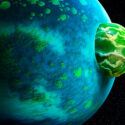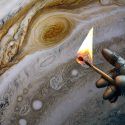In five billion years, we’re gonna have a hefty problem on our hands. Well, only if we’re still living on Earth at this point. Our Sun will be on the brink of collapse. If we don’t find a way to give it all the fuel it needs, well, we’re toast.
How could Jupiter help us refuel the Sun? What other stars have consumed gas giants? What would life be like without Jupiter?
The Sun’s delicate balance of hydrogen (H) and helium (He) keeps us alive and well. Although you might think there’s an infinite ball of energy up there, I hate to break it to you, but the Sun’s not sticking around forever.
In order to keep it going, our Sun needs a consistent source of hydrogen. At its core, the Sun’s hydrogen is converted to helium in the process of nuclear fusion. This fusion reaction is exothermic, meaning it gives off more energy than it consumes. This energy is released as gamma radiation, which provides enough of an outward push of gravity to keep the Sun from imploding.
So how exactly can Jupiter help with all of this? Well, about 90% of Jupiter’s atmosphere is made of hydrogen. This makes it one big ball of fuel, even though it’s only 0.01% the mass of the Sun.
Astronomers have located a Sun similar to ours that has been eating a Jupiter-like gas giant, called WASP-12b. Good one, science! I hate wasps too. WASP-12b’s atmosphere is being sucked up by its star, forming a hot ring of gas around it.
As its atmosphere is pulled outward, this is making the planet puff up to six times the size of Jupiter. The Sun gobbles up hydrogen at a rate of 620 million metric tons (683 million tons) per second. With four gas giants in our Solar System, we could keep the Sun sizzling for another 87 million years. With Jupiter being the biggest, we’d probably want to start there.
In order to pull this off, we’d need to set up Jupiter like WASP-12b, close enough to the Sun to deliver a constant influx of hydrogen from its atmosphere. It would have to be just enough hydrogen so that no mass is added or lost from the Sun. In other words, like a healthy diet and exercise with an occasional cheat day.
But couldn’t we just smash Jupiter into the Sun? That sounds more fun to me. Well, it would make for some good fireworks. But this would increase the Sun’s mass too quickly, causing it to burn hot enough to turn global warming into global roasting.
The key is to keep the Sun’s mass stable, so its fusion remains consistent at its core. Even if we managed to nudge Jupiter close enough to the Sun, that could lead to a whole slew of other problems.
Without Jupiter’s stable gravitational pull, all of our planetary orbits, including Earth’s, would be thrown off course. We’d lose our precious shield against deadly asteroids and comets. So, realistically, we’d probably have to suck it up and move somewhere else. Who knows, maybe there’s a nice Earth-like exoplanet out there for us to settle.
Sources
- “Science Explained: How Does Our Sun Work?”. Lim, Jappy. 2015. Futurism.
- “What Will The Sun Look Like After It Dies?”. livescience.com.
- “What Is The Sun Made Of? Table Of Element Composition”. Anne Marie Helmenstine. 2020. Thoughtco.
- “Jupiter Fact Sheet”. 2020. nssdc.gsfc.nasa.gov.
- “Could we Prolong the Life of our Sun?”. Bandon, Weigel. 2018. Medium.
- “Jupiter’s Atmosphere & The Great Red Spot”. Redd, Nola. 2018. space.com.
- “How Can We Save The Sun?”. Fraser, Cain. universetoday.com
- “What will happen when our sun dies?”. Byrd, Deborah, and Eleanor Imster. 2020. earthsky.org.



























